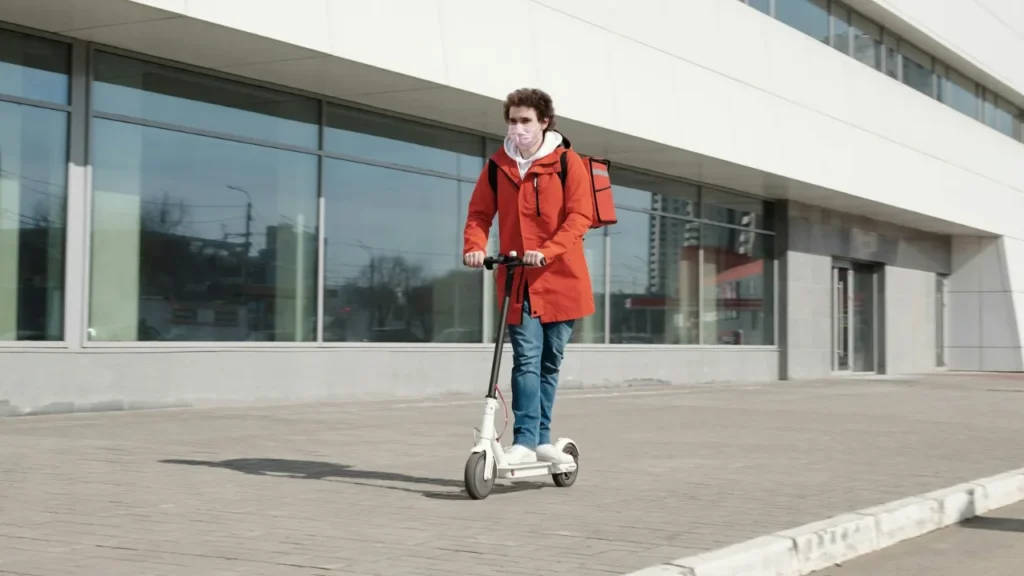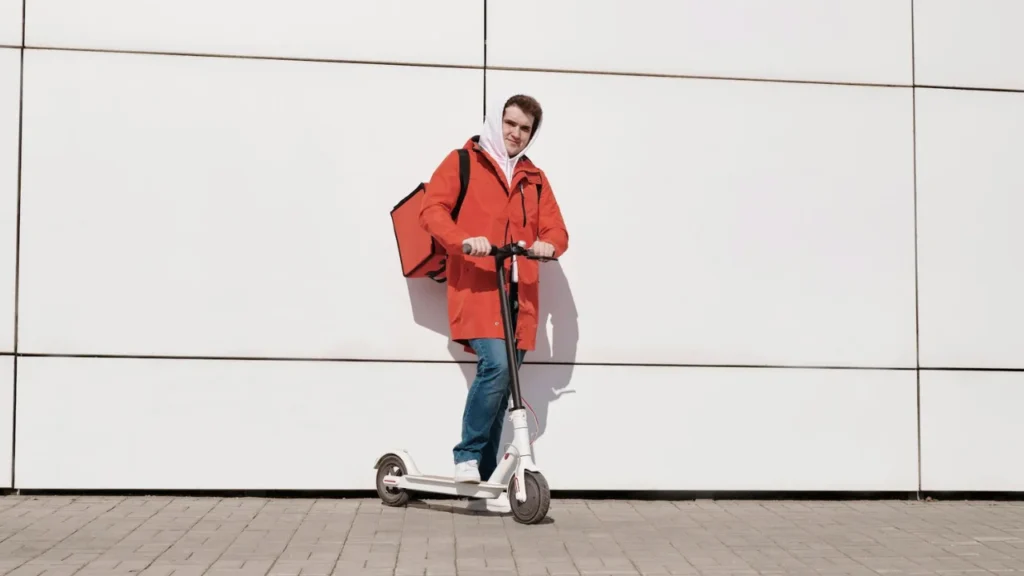You know, owning your first electric scooter is way more than just a way to get from point A to point B—it’s a full-on adventure! My first ride on my new scooter was an exhilarating experience that opened up a whole new world of possibilities for my daily commute.
So, my friend surprised me with this awesome electric scooter for my birthday, and I couldn’t wait to take it for a spin on my morning commute to a coworking space in downtown Brooklyn.
Zooming along at 16 mph, I was weaving through traffic like a pro, dodging cars, bikers, and even a few pigeons. Honestly, it felt amazing to glide past all the stop-and-go traffic. For a brief moment, I felt like a street-level superhero—totally invincible!
But then came the dreaded battery anxiety. I totally misjudged the range and barely made it to my destination with the battery sputtering like it was about to give up on me.
That last hill? It felt like I was climbing Everest! My legs were about ready to revolt if the scooter decided to quit on me. So, lesson learned: always check your battery before heading out, especially if you’ve got a long or hilly ride ahead!
Owning Your First Electric Scooter
Riding in the city is like navigating an obstacle course with traffic, curbs, and drivers who can be a little unpredictable. Always keep your eyes on the road ahead and plan your moves carefully. Don’t assume anyone sees you coming!
16 mph feels pretty fast, but the real key is control. Before you hit that top speed, take some time to get comfortable with balancing and braking. It’ll make your ride way more enjoyable and safer.
Know your scooter’s range and make sure to charge it fully before you head out. Running out of juice mid-ride isn’t just a hassle—it can be downright embarrassing!
Despite any hiccups along the way, my ride reminded me just how awesome scooters can be. The freedom, the speed, and that unique thrill make all the challenges totally worth it.
Your first electric scooter ride will definitely be a mix of fun and learning experiences. So go ahead—laugh at the little mistakes, learn from the bumps in the road, and get ready for even more adventures ahead!

What is an Electric Scooter?
Think of an electric scooter as the perfect blend of a bike and a hoverboard—compact, zippy, and powered by an electric motor.
Unlike traditional bikes, you don’t have to break a sweat to get from point A to B. They’re designed for everything from city commutes to suburban adventures, or even just cruising around for fun.
Electric scooters have quickly become the go-to choice for “cool commuters,” mixing practicality with a dash of excitement. And let’s not forget the eco-friendly bonus: they produce zero emissions, which means fewer polar bears giving you the side-eye! Plus, they’re super cost-effective—no gas, no metro cards, just a battery charge that costs less than your morning coffee.
If you’re on the fence about getting one—let me clear that up. Think you’re too old? Not a chance. Feeling nervous? That’s what practice is for!
The truth is scooters are for anyone who wants to zip around without the hassle of a full-blown vehicle. Whether you’re weaving through traffic or gliding through a park, scooters turn every ride into an adventure!
Factors to Consider Before Buying Your First Electric Scooter
So, you’re ready to join the e-scooter squad? Awesome choice! Before you dive in and splurge, let’s make sure you pick the right scooter for your needs—not just the one that looks cool in those Instagram ads.
Budget: Finding the Sweet Spot
Scooter prices can range from around $300 to a whopping $3,000 (or even more!). If you’re a casual rider looking for something for short commutes or weekend joyrides, aim for the $300-$500 range. Want a bit more speed and better features like suspension? Then consider spending between $800 and $1,500.
If you really want to go all out, you’ll find premium models that are long-range powerhouses with motors that’ll get your adrenaline pumping. Just remember to prioritize what you really need—don’t drain your savings on features you might never use!
Performance Metrics: Speed, Range, and Motor Power
Are you dreaming of zipping through city streets or just cruising to your favorite coffee shop? Speed varies by scooter, usually topping out between 15-30 mph (don’t worry, you’re not entering a Formula 1 race!). Range is another big factor—most scooters can go about 10-25 miles on a single charge.
And let’s talk motor power: a 250-watt motor is fine for flat terrain, but if you’re tackling hills or carrying extra weight, aim for 500 watts or more. Also, check if it has one motor or two—dual motors can double the fun (and maybe your budget)!
Portability: Easy to Carry or a Total Hassle?
Portability can make or break your scooter experience, especially if you need to carry it up stairs or store it in tight spaces. Look for foldable models and lightweight designs (around 20-30 pounds is ideal for most commuters). If it feels heavy enough to be a workout, you might want to think twice.
Pro tip: Before buying, test how easy it is to fold and carry—you don’t want to struggle with it every time you hop on the train!
Safety Features: Don’t Skimp on This
When it comes to safety, don’t cut corners. Make sure your scooter has solid brakes, good lights, and durable tires. Opt for dual braking systems (like disc and regenerative brakes) for reliable stopping power.
Bright front and rear lights are essential for night rides or those gloomy days. And choose tires that fit your usual terrain; if the roads are slick, look for ones with grippy treads. Bonus points if your scooter has suspension—especially if your city is full of potholes!
Build Quality and Extras: More Than Just Looks
You want a sturdy frame that can handle the occasional bump or spill. If you ride in unpredictable weather, look for something with water resistance. An intuitive display showing speed and battery life is super handy too.
As for extras? Features like Bluetooth app connectivity, cruise control, and swappable batteries can make life easier—just make sure they fit into your lifestyle.
The important thing is to consider how and where you plan to use your electric scooter. Spending big on something ultra-fast for short, flat rides doesn’t make sense, just as skimping on power isn’t wise if you’re facing hills every day.
Choose wisely—you’ll thank yourself later when you’re gliding along with a big smile on your face!

Pre-Ride Checklist for Beginners
Before you hop on your scooter like a pro, let’s make sure you’re actually prepared. Here’s how to avoid turning your first ride into a crash course in “what not to do”:
Gear Up Like a Boss: First things first! Helmets are a must, not an option. Go for something lightweight but protective—skater-style helmets are a great choice. And if you’re still getting the hang of things, consider adding knee and elbow pads for extra safety. If you’re riding early in the morning or at dusk, throw on some reflective clothing or strips. Remember, safety comes before style!
Tire TLC: Give your tires some love before you hit the road. Check the air pressure and look for any signs of wear. If they seem a bit flat, pump them up to the recommended PSI (you can usually find this info on the tire sidewall or in your manual). And if you have solid tires? Lucky you! They require less maintenance, but it’s still good to give them a quick inspection.
Battery Check: Make sure to charge your scooter fully before heading out. Keep an eye on that battery level because nothing kills your vibe like having to push a dead scooter home. If you’re planning a longer trip, consider bringing along a portable power bank as a backup.
Test Your Lights: Your front and rear lights aren’t just for show—they’re essential for staying safe, especially in low-light conditions. Make sure they’re working properly before you hit the road.
Adjust Your Handlebars: This isn’t a one-size-fits-all situation! Adjust your handlebars to a comfortable height—ideally around hip level—so you’re not hunched over or reaching awkwardly like a kid on stilts.
Brake Test: Your brakes should feel responsive—not jerky. Give them a gentle squeeze in a safe spot to make sure they’re working well. If they feel loose or squishy, don’t ride until you’ve fixed them. Trust me, loose brakes are bad news!
Controls Warm-Up: Take a few minutes to familiarize yourself with the throttle, brakes, and any other controls on your scooter. Find an open space where you can practice accelerating and braking smoothly without wobbling around like a newborn deer.
Check the Terrain: Remember, your scooter isn’t invincible! Gravel, potholes, and slick sidewalks can send you flying if you’re not careful. Plan your route with smooth paths in mind, especially for those first rides.
Know Your Weight Limit: Every scooter has a weight limit, so don’t overload it with heavy backpacks or groceries. Doing so could damage the motor—or worse, ruin your ride!
Stretch it Out: It might sound silly, but taking a moment to stretch can really help keep you limber, especially if you’re riding for more than 20 minutes. Trust me—tight calves and sudden stops don’t mix well!
Bring the Basics: Don’t forget the essentials: your phone, ID, a small tool kit, and some cash (just in case). Riding isn’t the time to go full minimalist!
This isn’t just about staying safe; it’s about setting yourself up for a smooth ride without any drama. Think of it as your pre-scooter ritual—kind of like warming up before a run. Skip it, and you might regret it when something goes sideways!

Why Choose an Electric Scooter?
Eco-Friendly Wins: Electric scooters are powered by batteries, not gas, which means you can feel good about your carbon footprint. Every ride is a little victory for the planet (and your conscience). If you’ve ever wanted to be both cool and environmentally friendly, now’s your chance!
Seriously Fun: Who says commuting has to be boring? Scooters turn the everyday grind into an adventure, whether you’re cruising through a park or weaving through city streets. It’s transportation with a healthy dose of fun!
Cost-Effective Commutes: Say goodbye to high gas prices and pricey metro cards! The energy costs for a scooter are incredibly low—think just pennies per charge. Plus, with fewer moving parts than cars or bikes, maintenance is a breeze and much cheaper. Your wallet will definitely thank you!
Ridiculously Convenient: Scooters are all about grab-and-go convenience. No parking hassles, no traffic headaches, and no complicated setup. They’re perfect for short commutes, running errands, or those lazy days when you just don’t feel like pedaling a bike.
The Rising Trend: Scooters aren’t just a passing trend—they’re here to stay! Cities around the world are embracing them as a smart alternative to cars. With bike lanes and scooter-sharing programs popping up everywhere, it’s easier than ever to join the movement!
For Everyone, No Exceptions: Think you’re too old for a scooter? Not at all! Too inexperienced? You’ll get the hang of it in no time. Whether you’re a college student, a busy professional, or just someone who loves feeling the wind in your hair, there’s a scooter out there for you.
Tips for the First 30 Days of Ownership
Ride Smart: Take it easy at first. Stick to safe speeds and avoid busy roads while you’re still getting the hang of things. Keep an eye out for uneven surfaces, potholes, and other hazards that could turn a smooth ride into an unexpected tumble. And if it’s wet outside? Be extra cautious—scooter tires don’t like slippery surfaces!
Maintenance Basics: Think of your scooter as a trusty sidekick, not just an afterthought. Give it a wipe-down after rainy rides to prevent rust, check the tire pressure weekly (if you have air-filled tires), and keep an eye on how responsive the brakes feel. For the battery, remember this golden rule: never let it run all the way down, and avoid overcharging it. Aim to charge it when it hits around 20-30%.
Build Confidence: Look for low-traffic spots, empty parking lots, or quiet streets to practice your skills. Focus on mastering the basics—starting, stopping, and turning at different speeds. As you get more comfortable, gradually challenge yourself with tougher routes.
Weather Awareness: Scooters are pretty versatile, but they’re not invincible. Steer clear of deep puddles, heavy rain, or icy conditions. If you live in a rainy area, consider getting a water-resistant model or adding accessories like fenders to keep those pesky splashes at bay.
- Also Read: Can You Ride an Electric Scooter in the Rain
Explore Different Terrains: Once you’re feeling confident, try riding on different surfaces. Asphalt, concrete, and even light gravel will help you understand how your scooter handles various terrains. Pay attention to how braking and acceleration change with each surface—you’ll be glad you did when something unexpected comes up!
Embrace Your First 30 Days: Your first month is all about exploration and learning. Don’t rush things—allow your scooter to become an extension of yourself, and before you know it, you’ll be riding like a pro!
Long-Term Considerations for Scooter Owners
Maintenance Costs: Electric scooters are pretty low-maintenance, but that doesn’t mean they’re maintenance-free. You’ll want to plan on replacing the battery every couple of years, depending on how much you ride, and keep an eye on tire wear—especially if you’re using your scooter daily. It’s also a good idea to budget for occasional tune-ups or repairs, like brake adjustments or motor tweaks. Being proactive with maintenance helps you avoid any costly surprises down the line.
The Long-Term Eco Benefits: Every mile you scoot instead of drive adds up over time. Fewer car trips mean lower carbon emissions, and the energy-efficient design of scooters ensures you’re making a positive impact on the environment. If sustainability is important to you, riding a scooter is like wearing a badge of eco-conscious pride!
Accessories and Customizations: Once you settle into your scooter lifestyle, think about investing in some accessories to enhance your rides. Consider adding phone mounts for easy navigation, better lighting for those night rides, or panniers for carrying your gear. Customizing your scooter not only makes it uniquely yours but also adds a touch of practicality!
Upgrading as You Improve: As you get more skilled and confident on your scooter, you might find yourself wanting more power, speed, or range. Upgrading to a mid-range or high-performance scooter can really expand your options—think tackling steeper hills or exploring longer routes. Just keep in mind that more power often means more weight, so make sure to balance your need for speed with how portable you want your ride to be.
Understanding Legal and Safety Regulations
Helmet and Safety Requirements: While some areas legally require helmets, it’s a good idea to wear one no matter what. Reflective clothing, front and rear lights, and a bell or horn can help keep you visible and safe. Also, check if your city has any additional safety gear requirements you need to follow.
Speed Limits and Road Etiquette: Many places have speed limits for scooters, usually ranging from 10 to 20 mph. Be mindful of areas with lots of pedestrians and always yield to foot traffic when you’re on the sidewalks. When sharing the road with bikes or cars, try to stick to bike lanes whenever possible and ride predictably to keep everyone safe.
Know the Local Laws: When it comes to electric scooters, the rules can really vary depending on where you live. Some cities let you ride in bike lanes, while others say you have to stick to the sidewalks, and a few places don’t allow scooters at all. Make sure to do your homework on your area’s regulations so you can avoid any fines or awkward encounters with the law.
Age Restrictions and Licenses: Some places have age limits or require specific licenses for using electric scooters. This might not be the case everywhere, but it’s definitely worth checking out if you’re thinking about gifting a scooter to a younger rider or planning to ride in a new location.
Parking and Storage Rules: Improperly parked scooters can lead to hefty fines or even towing, so be careful where you leave yours. Many cities have designated areas for parking shared scooters, so make sure to do the same with your personal one. Avoid blocking sidewalks, entrances, or bike racks. Following these regulations isn’t just about dodging tickets—it’s also about keeping yourself and others safe. Take the time to learn and respect the rules of the road!
Final Words
Scooters are about so much more than just getting from point A to point B—they’re all about the journey, the freedom, and a dash of adventure along the way. Sure, you might have a few wobbles and share some laughs at your own expense, but that’s all part of the fun! Here’s what you should keep in mind as you get started:
Electric scooters are a fantastic, eco-friendly, and budget-friendly way to get around. Before you make a purchase, think about your budget, what kind of performance you need, how portable it is, and what safety features it has.
Always give your scooter a quick check before you ride—gear up, test those brakes, and make sure your battery is fully charged.
Don’t forget to follow local laws and prioritize safety to keep your rides enjoyable and stress-free. The road ahead might have its bumps, but trust me, the ride will always be worth it. So, what are you waiting for? Hop on and experience the joy for yourself!